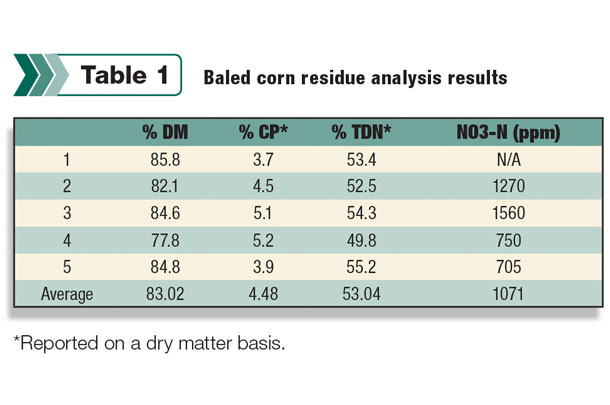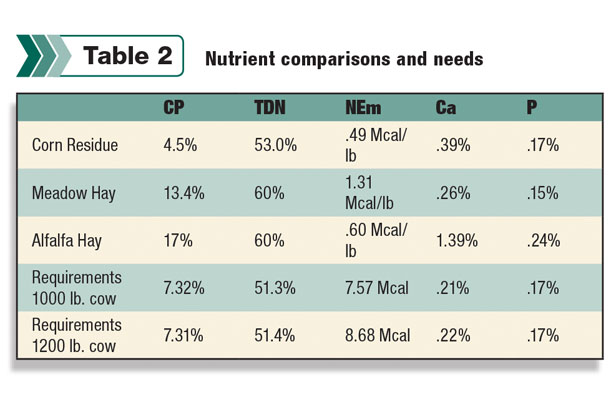High feed prices often force cow-calf producers to search for lower-cost feed alternatives in order to stretch existing hay and forage supplies. Grazing crop residues, such as grain fields that have been irrigated after harvest or cornstalk residue, is common.
Likewise, feeding baled cornstalks is becoming more commonplace in many areas. Utilizing crop residues can reduce feed costs; however, there are several factors that should be considered.
Feed value
Perhaps the greatest challenge in utilizing any crop residue as a feed source is the wide variation in nutrient content and digestibility. Sprouted grains are high in nutrient value, although straw residue and plant density (number of sprouted plants per acre) can impact intake.
Nutrient content of cornstalks declines with each day cattle are in the field. Cattle will first seek out and consume any missed ears, spilled kernels, leaves and cornhusks. They will then consume the more lignified stalks, which are of much lower nutrient value.
The nutrient value of baled cornstalks can vary greatly depending on field conditions and harvest methods. Some growers simply bale the windrow left from the combine, while others will swath all remaining cornstalks and then rake them into a larger windrow.
Swathing and raking cornstalk residue will increase the tons per acre harvested but will also increase the amount of lignified stalks and dirt content of the bales.
Table 1 shows the variation that existed in several different loads from northeast Oregon in 2007.
Feed comparisons
In order to place an appropriate value on crop residues, producers can make comparisons with more common forages or feedstuffs such as alfalfa or meadow hay. Crude protein and energy should be the first comparisons made. It is easiest to compare on a cost-per-pound-of-nutrient basis. To make this comparison, multiply the quantity of the feedstuff by the percent of the nutrient in the feed.
This will give you the number of pounds of the actual nutrient in the feed. Next, divide the price of the feedstuff by the number of pounds of the nutrient in the feed to get the price per pound of the nutrient.
For example, alfalfa hay that is 17 percent crude protein and $180 per ton would cost about $0.53 per pound of crude protein.
$180 / (2,000 pounds x 0.17) = $0.529 per pound
Moisture should also be considered and adjusted to accurately compare different feed sources. When the samples in Table 1 are adjusted for moisture to match alfalfa hay (89 percent dry matter), the price for $55- per-ton baled corn residue becomes $58.30 per ton. Eighty-five-dollar-per- ton baled corn residue is now $91.10 per ton.
Next, the percentage content of each nutrient should be considered. How do those figures compare to each other and to the cow’s actual nutrient needs? Table 2 shows those comparisons.

In order for a 1,200-pound cow to meet just her maintenance needs for net energy (NEm), she must consume 21.3 pounds of corn residue daily on an as-fed basis. It is not possible to meet her protein needs from cornstalks alone, as the protein content of cornstalks is below that needed by rumen microbes for proper function.
Rate of passage of baled corn residue will be much slower than with higher-quality feeds. This will reduce intake and make it impossible to meet a cow’s nutrient requirements solely with baled corn residue.
Intake and cow performance can be increased by supplementing protein, preferably from a natural source such as alfalfa, canola meal, sunflower meal, etc.
Other considerations should include feeding methods and dirt content. Unlimited access to scattered round bales of cornstalks or hay can result in up to a 40 percent loss due to waste.
It has also been reported that some cornstalk bales can contain up to 8 percent dirt by weight. Farmers swathing and baling cornstalks attempt to pick up as much stubble as possible, which may result in increased dirt contamination. It is important to consider these and other additional factors when determining the true value of baled crop residue.
Grazing
The most cost-effective method of utilizing crop residue is by grazing. This eliminates the fuel and machinery cost associated with harvesting the residue. One common problem with grazing crop residues is a lack of fences around fields.
This can be easily remedied by utilizing portable electric fencing. Portable electric fencing can also be used to strip-graze the field, which greatly increases utilization rate.
Research shows that a three-day strip-graze yields 40 percent more grazing days per acre as compared to a 14-day strip-graze. Water is also a consideration. In many instances, producers will have to haul water to fields to meet animal needs.
Animal class
Dry pregnant (mid-gestation) mature cows are best suited to utilize crop residues. Their nutritional requirements are low as compared to lactating and late-gestation animals. Growing calves, feeder cattle and replacement heifers will generally require supplementation of protein or energy to maintain desirable growth rates.
Other considerations
When feeding crop residue, it is important to consider any possible negative effects of the feed. For example, certain types of grass seed straw can have high levels of alkaloids that can negatively affect cows, such as fescue toxicosis.
All cereal grain hays should be tested for nitrates, and cornstalks are no different. Table 1 shows the nitrate-nitrogen (NO3-N) levels of the tested corn residue hay sampled in northeast Oregon.
While not alarmingly high, samples 2 and 3 should not be fed at a rate greater than 50 percent to pregnant cattle, as nitrate toxicity may occur and cows may abort fetuses or die.
One other consideration in moisture content should be the potential for mold developing in the bale. Bales that are less than 85 percent dry matter can develop mold if stored for very long.
Summary
Crop residue can be effectively utilized to reduce feed costs. It is important, however, to consider more than just price. Producers should consider the class of animals to be fed, harvesting method, and nutrient and moisture content of any baled residue and should be willing to test for quality as well as nitrate content.
References omitted due to space but are available upon request. Click here to email an editor.







